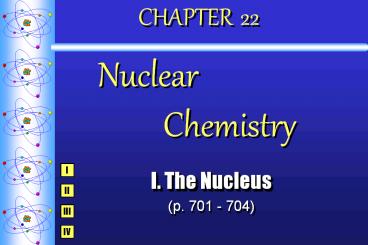CHAPTER 22 Nuclear Chemistry - PowerPoint PPT Presentation
Title:
CHAPTER 22 Nuclear Chemistry
Description:
Others Food Irradiation radiation is used to kill bacteria Radioactive Tracers explore chemical pathways trace water flow study plant growth, ... – PowerPoint PPT presentation
Number of Views:83
Avg rating:3.0/5.0
Title: CHAPTER 22 Nuclear Chemistry
1
CHAPTER 22 Nuclear Chemistry
I
- I. The Nucleus
- (p. 701 - 704)
II
III
IV
2
A. Mass Defect
- Difference between the mass of an atom and the
mass of its individual particles.
4.00260 amu
4.03298 amu
3
B. Nuclear Binding Energy
- Energy released when a nucleus is formed from
nucleons. - High binding energy stable nucleus.
E mc2
E energy (J) m mass defect (kg) c speed of
light (3.00108 m/s)
4
B. Nuclear Binding Energy
Unstable nuclides are radioactive and undergo
radioactive decay.
5
Stable Nuclei
6
CHAPTER 22 Nuclear Chemistry
I
- II. Radioactive Decay
- (p. 705 - 712)
II
III
IV
7
A. Types of Radiation
- Alpha particle (?)
- helium nucleus
paper
2
- Beta particle (?-)
- electron
1-
lead
- Positron (?)
- positron
1
concrete
- Gamma (?)
- high-energy photon
0
8
B. Nuclear Decay
- Alpha Emission
Numbers must balance!!
9
B. Nuclear Decay
- Beta Emission
- Positron Emission
10
B. Nuclear Decay
- Electron Capture
- Gamma Emission
- Usually follows other types of decay.
- Transmutation
- One element becomes another.
11
B. Nuclear Decay
- Why nuclides decay
- need stable ratio of neutrons to protons
DECAY SERIES TRANSPARENCY
12
B. Synthetic Elements
- Transuranium Elements
- elements with atomic s above 92
- synthetically produced in nuclear reactors and
accelerators - most decay very rapidly
13
- Stop
14
C. Radioactive Dating
- half-life measurements of radioactive elements
are used to determine the age of an object - decay rate indicates amount of radioactive
material - EX 14C - up to 40,000 years 238U and 40K - over
300,000 years
15
D. Nuclear Medicine
- Radioisotope Tracers
- absorbed by specific organs and used to diagnose
diseases - Radiation Treatment
- larger doses are used to kill cancerous cells
in targeted organs - internal or external radiation source
16
F. Others
- Food Irradiation
- ? radiation is used to kill bacteria
- Radioactive Tracers
- explore chemical pathways
- trace water flow
- study plant growth, photosynthesis
- Consumer Products
- ionizing smoke detectors - 241Am
17
Half Life
- The rate at which radioactive nuclides decay is
dependent upon the amount of the nuclide present
to begin with. - Decay rate is usually expressed in terms of half
life, the amount of time it takes for half of a
sample to decay.
18
Illustrative Example - 20 min. Half Life
Original sample 32 nuclei After 20 min., half
is left. After another 20 min., one fourth is
left. One eighth is left after another 20 min.
Number of atoms
decayed
0
19
Another Example
20
C. Half-life
- Half-life (t½)
- Time required for half the atoms of a radioactive
nuclide to decay. - Shorter half-life less stable.
21
- The half-life of cobalt-60 is 10.47 minutes. How
many mg of cobalt-60 remain after 104.7 minutes
if you start with 10.0 mg?
22
C. Half-life
mf final mass mi initial mass n of half-lives
23
C. Half-life
- Fluorine-21 has a half-life of 5.0 seconds. If
you start with 25 g of fluorine-21, how many
grams would remain after 60.0 s?
GIVEN t½ 5.0 s mi 25 g mf ? total time
60.0 s n 60.0s 5.0s 12
WORK mf mi (½)n mf (25 g)(0.5)12 mf 0.0061
g






























